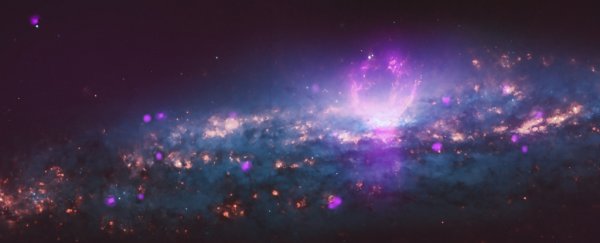Sixty-seven million light-years away, a galaxy is blowing enormous bubbles. We know what they are. Known as nuclear superbubbles, the structures are likely created by the supermassive black hole in the galaxy's centre. Now, thanks to new data, we know something incredible is occurring inside them.
Observations from NASA's Chandra X-ray Observatory of spiral galaxy NGC 3079 have revealed that the bubbles are actually a huge cosmic particle accelerator, producing energetic high-speed particles around their edges.
Nuclear superbubbles are like a younger version of something called Fermi bubbles, which we have here in the Milky Way galaxy, too. Astronomers think these occur when the supermassive black hole at the centre of a galaxy feeds (known as an active galactic nucleus).
When a black hole is feeding, enormously powerful jets of plasma shoot from its poles, at velocities approaching light speed. How this happens is unclear, but astronomers think that material from the inner part of the accretion disc is channelled towards and launched from the poles via the magnetic field lines around the outside of the black hole.
So these jets, the hypothesis goes, rocket out into space, carving huge cavities into the space above and below the galactic plane. In the Milky Way, the Fermi bubbles span a distance of about 50,000 light-years, so the feeding event that caused them (if feeding event it was) must have occurred some time ago.
 (X-ray: NASA/CXC/University of Michigan/J-T Li et al.; Optical: NASA/STScI)
(X-ray: NASA/CXC/University of Michigan/J-T Li et al.; Optical: NASA/STScI)
NGC 3079's bubbles are a little smaller - one is 4,900 light-years across, the other 3,600 light-years - so they're probably a bit younger. But they're also really good to study. The bubbles are at a distance, which means it's easier for us to see them in their entirety; and because they're younger, they can help us understand the evolution of these objects.
So astronomers took a look with Chandra, and found something strange in the data - features in the highest energy X-rays consistent with synchrotron emission. In other words, that there is a giant particle accelerator.
In fact, this is the first direct evidence of synchrotron radiation emanating from galactic bubbles - although, oddly, it was only detected in one of them, the smaller one.
 This is just the X-ray data. (NASA/CXC/University of Michigan/J-T Li et al.)
This is just the X-ray data. (NASA/CXC/University of Michigan/J-T Li et al.)
As the bubbles expand into the surrounding gas of the interstellar medium, they generate shock waves, which in turn produce tangled magnetic fields. According to the research team from the University of Michigan, particles ricochet around these shock magnetic fields; when they pass through the shock front, they get an acceleration boost.
These particles could not have originated in the galactic centre - they would have lost too much energy by the time they reached the edge of the bubble.
This accelerator effect could result in particles 100 times more energetic than the Large Hadron Collider's capabilities. If this happens, it could be the source of another mysterious phenomenon - cosmic rays.
We don't know what produces these extremely energetic particles. In fact, we've only recently discovered that they can come from outside the Milky Way.
But if Fermi bubbles were acting as a particle accelerator, and some of these accelerated particles escaped the bubbles, it's possible they could eventually make their way to Earth as cosmic rays.
That's a lot of maybes, but it's not like we can just go there and look (although that would be amazing). We don't even know for sure that it's a black hole that makes the bubbles - it could be powerful stellar winds from baby stars.
"Future deeper radio/X-ray observations, careful measurement and modelling of the magnetic field, as well as theoretical modelling of the superbubble in different scenarios, will help to better examine the nature of the hard X-ray excess in the SW bubble and to better understand the origin of galactic nuclear superbubbles," the researchers wrote in their paper.
Time - and more research - is bound to reveal more about these fascinating structures, along with providing some firm answers.
The research has been published in The Astrophysical Journal.
